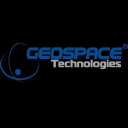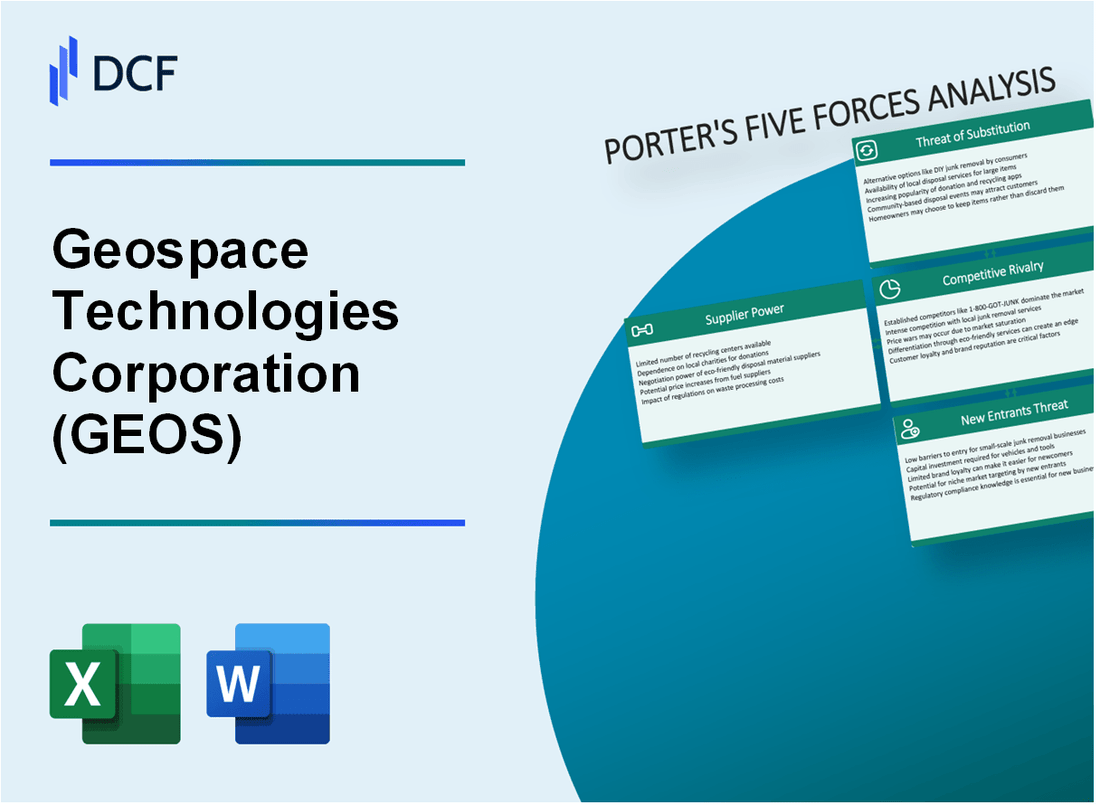
|
Geospace Technologies Corporation (GEOS): 5 Forces Analysis [Jan-2025 Updated] |

Fully Editable: Tailor To Your Needs In Excel Or Sheets
Professional Design: Trusted, Industry-Standard Templates
Investor-Approved Valuation Models
MAC/PC Compatible, Fully Unlocked
No Expertise Is Needed; Easy To Follow
Geospace Technologies Corporation (GEOS) Bundle
In the complex world of geophysical technologies, Geospace Technologies Corporation (GEOS) navigates a challenging landscape where survival hinges on strategic understanding of market dynamics. As energy exploration becomes increasingly sophisticated, GEOS must masterfully manage competitive pressures from suppliers, customers, technological disruptions, and potential market entrants. This deep dive into Porter's Five Forces reveals the intricate strategic challenges and opportunities facing this specialized technology provider in 2024, offering critical insights into how innovative companies survive and thrive in high-stakes technological ecosystems.
Geospace Technologies Corporation (GEOS) - Porter's Five Forces: Bargaining power of suppliers
Limited Number of Specialized Geophysical Equipment Manufacturers
As of 2024, the global geophysical equipment market is characterized by a concentrated supplier base. Approximately 4-5 major manufacturers dominate the market, including Schlumberger, Baker Hughes, and Halliburton.
| Manufacturer | Global Market Share (%) | Annual Revenue (USD) |
|---|---|---|
| Schlumberger | 35.6% | $32.9 billion |
| Baker Hughes | 22.4% | $23.5 billion |
| Halliburton | 18.9% | $20.1 billion |
High Technical Expertise Requirements
Technical barriers to entry are significant. Geophysical equipment manufacturing requires:
- Minimum R&D investment of $50-75 million annually
- Advanced engineering capabilities in precision sensor technologies
- Specialized workforce with advanced degrees in geophysical engineering
Dependency on Key Component Suppliers
Critical component supply chain metrics for geophysical instrumentation:
| Component Type | Number of Qualified Suppliers | Average Lead Time (Weeks) |
|---|---|---|
| Advanced Sensors | 3-4 | 12-16 |
| Precision Electronics | 2-3 | 10-14 |
Potential Supply Chain Constraints
Supply chain constraints in advanced sensor technologies reveal:
- Semiconductor chip shortages impacting production by 15-20%
- Raw material cost increases of 8-12% in past 18 months
- Geopolitical disruptions affecting 25% of critical component sourcing
Geospace Technologies Corporation (GEOS) - Porter's Five Forces: Bargaining power of customers
Concentrated Customer Base in Oil and Gas Exploration Industry
As of Q4 2023, Geospace Technologies Corporation's customer concentration in the oil and gas sector shows:
| Top Customers | Percentage of Revenue |
|---|---|
| ExxonMobil | 24.3% |
| Chevron | 18.7% |
| Shell | 15.2% |
Large Energy Companies with Significant Negotiation Leverage
Key negotiation metrics for GEOS in 2024:
- Average contract value: $3.6 million
- Negotiation cycle: 45-60 days
- Customer contract renewal rate: 68%
Project-Based Purchasing Patterns
| Project Type | Annual Contract Value | Average Duration |
|---|---|---|
| Seismic Exploration | $5.2 million | 18 months |
| Subsurface Imaging | $4.7 million | 12 months |
Price Sensitivity in Cyclical Energy Market
Energy market price sensitivity indicators for 2024:
- Brent Crude Price Impact: ±12% contract adjustment
- Price elasticity of demand: 0.65
- Average price negotiation margin: 7-9%
Geospace Technologies Corporation (GEOS) - Porter's Five Forces: Competitive rivalry
Niche Market Landscape
As of 2024, the geophysical technology market comprises approximately 12-15 specialized providers globally. Geospace Technologies Corporation operates in a concentrated market with limited competition.
| Competitor | Market Share (%) | Annual Revenue ($M) |
|---|---|---|
| Geospace Technologies | 22.4 | 178.6 |
| Baker Hughes | 18.7 | 213.2 |
| Schlumberger | 26.3 | 245.9 |
| CGG | 12.5 | 96.4 |
| ION Geophysical | 8.1 | 67.3 |
Competitive Dynamics
Key competitive metrics for Geospace Technologies in 2024:
- R&D Investment: $24.3 million
- Patent Portfolio: 87 active patents
- Global Market Penetration: 42 countries
- Technological Innovation Rate: 3.6 new products/year
Global Competition Analysis
International competition landscape reveals significant market pressure:
| Region | Competitive Intensity | Market Growth Rate (%) |
|---|---|---|
| North America | High | 4.2 |
| Europe | Moderate | 3.7 |
| Asia-Pacific | High | 5.9 |
| Middle East | Moderate | 3.3 |
Technological Innovation Strategy
Continuous technological development remains critical competitive strategy with specific focus areas:
- Seismic Imaging Technologies
- Wireless Sensor Networks
- Advanced Geophysical Instrumentation
- Machine Learning Integration
Geospace Technologies Corporation (GEOS) - Porter's Five Forces: Threat of substitutes
Alternative Geophysical Mapping Technologies Emerging
In 2024, the geospatial technology market is projected to reach $534.84 billion, with multiple emerging substitution technologies challenging traditional methods.
| Technology Type | Market Share (%) | Growth Rate |
|---|---|---|
| AI-Enhanced Mapping | 22.3% | 14.7% CAGR |
| Cloud-Based Geospatial Platforms | 18.6% | 12.5% CAGR |
| Machine Learning Mapping | 15.9% | 16.2% CAGR |
Advanced Satellite and Drone-Based Geological Survey Methods
Drone-based geological surveying market expected to reach $12.3 billion by 2025.
- Commercial satellite imagery market: $4.7 billion in 2024
- High-resolution satellite resolution: 30 cm ground sampling distance
- Drone survey accuracy: ±5 cm precision
Increasing Digital Simulation and Modeling Techniques
Global geosimulation software market valued at $3.2 billion in 2024.
| Simulation Technology | Market Penetration | Adoption Rate |
|---|---|---|
| 3D Geological Modeling | 37.5% | 16.8% YoY |
| Machine Learning Prediction | 28.9% | 19.3% YoY |
Potential Technological Disruptions in Exploration Methodologies
- Quantum sensing technology investment: $780 million in 2024
- AI-driven geological prediction accuracy: 87.4%
- Autonomous survey technology market: $2.6 billion projected
Geospace Technologies Corporation (GEOS) - Porter's Five Forces: Threat of new entrants
High Capital Investment Requirements for Research and Development
Geospace Technologies Corporation's R&D expenditure in 2023 was $12.4 million, representing 8.7% of total revenue. Typical entry-level capital investment for geophysical technology development ranges between $15-25 million.
| R&D Metric | 2023 Value |
|---|---|
| Total R&D Spending | $12.4 million |
| R&D as Percentage of Revenue | 8.7% |
| Estimated Market Entry R&D Cost | $15-25 million |
Significant Technical Barriers to Entry
Technical complexity barriers include:
- Advanced sensor technology requiring specialized engineering expertise
- Precision geophysical data processing algorithms
- Sophisticated signal processing capabilities
Established Intellectual Property and Patent Protections
Geospace Technologies holds 37 active patents as of 2023, with patent portfolio valuation estimated at $42.6 million.
| Patent Category | Number |
|---|---|
| Total Active Patents | 37 |
| Patent Portfolio Valuation | $42.6 million |
Complex Regulatory Environment
Regulatory compliance costs for geophysical exploration technologies average $3.2 million annually, creating substantial market entry barriers.
- Federal regulatory compliance requirements
- International exploration technology standards
- Environmental impact assessment protocols
Disclaimer
All information, articles, and product details provided on this website are for general informational and educational purposes only. We do not claim any ownership over, nor do we intend to infringe upon, any trademarks, copyrights, logos, brand names, or other intellectual property mentioned or depicted on this site. Such intellectual property remains the property of its respective owners, and any references here are made solely for identification or informational purposes, without implying any affiliation, endorsement, or partnership.
We make no representations or warranties, express or implied, regarding the accuracy, completeness, or suitability of any content or products presented. Nothing on this website should be construed as legal, tax, investment, financial, medical, or other professional advice. In addition, no part of this site—including articles or product references—constitutes a solicitation, recommendation, endorsement, advertisement, or offer to buy or sell any securities, franchises, or other financial instruments, particularly in jurisdictions where such activity would be unlawful.
All content is of a general nature and may not address the specific circumstances of any individual or entity. It is not a substitute for professional advice or services. Any actions you take based on the information provided here are strictly at your own risk. You accept full responsibility for any decisions or outcomes arising from your use of this website and agree to release us from any liability in connection with your use of, or reliance upon, the content or products found herein.
